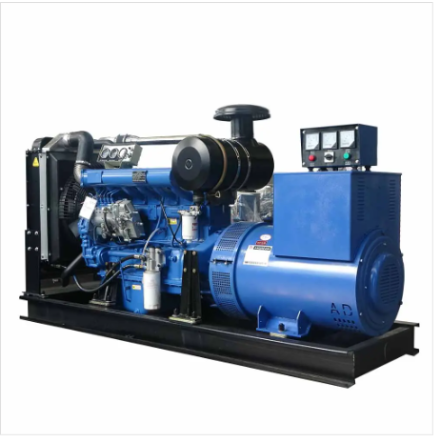तपाईंको लागि शक्ति आवश्यकता समझन डिजेल जनरेटर सेट
कुल भार र उपकरण वॉटेज कalkulation
कुन डिजेल जेनेरेटरको आकारले उत्तम काम गर्नेछ भन्ने निर्धारण गर्दा, सबैभन्दा पहिला ब्याकअप बिजुलीको आवश्यकता पर्ने सम्पूर्ण विद्युतीय उपकरणहरूको सूची बनाउनुहोस्। केवल बत्ती र हिटिङ सिस्टम जस्ता स्पष्ट चीजहरू मात्र सोच्नुहोस् न। एयर कन्डिशनर, प्रशीतन उपकरणहरू, कार्यालयका कम्प्युटरहरू पनि प्रायः बिर्सिन्छन् तर चलाउँदा धेरै बिजुली खपत गर्छन्। सूचीमा रहेका प्रत्येक वस्तुको निर्माताको विनिर्देश अनुसार सामान्य सञ्चालन वाट र सुरुवाती भोल्टेज आवश्यकता दुवै जाँच गर्नुहोस्। धेरै मानिसहरूले यी सुरुवाती भोल्टेजलाई गणना गर्न बिर्सन्छन् जसले गर्दा गणना गलत हुन सक्छ। यी मानहरू गणना गर्न मद्दत गर्ने अनलाइन औजारहरू उपलब्ध छन्, यद्यपि यसको ठाँउमा भिन्नता हुन सक्छ यदि इनपुट डाटा कति विस्तृत छ भन्ने आधारमा। सबै यी नम्बरहरू सङ्कलन गरिसकेपछि, एक कुल लोड अनुमानित मात्रा प्राप्त गर्न यसलाई जोड्नुहोस्। यो सङ्ख्या उचित जेनेरेटर छान्नका लागि आधारभूत आधार हो किनभने जेनेरेटरले भारी मागलाई सामना गर्दा ओभरलोड हुन नपर्ने वा महत्वपूर्ण समयमा आधारभूत आवश्यकता पूरा नगर्ने भएकोले।
शुरुआती र चालू वॉटेजमा फरक बाट
डिजेल जेनेरेटर छान्दा स्टार्टिङ (वा सर्ज) वाटेज र रनिङ वाटेजको भिन्नता थाहा पाउनु धेरै महत्वपूर्ण हुन्छ। अधिकांश उपकरणहरू र मोटरहरूले सामान्य रूपमा चलिरहेको अवस्थाको तुलनामा सुरुवातमा अधिक शक्तिको आवश्यकता पर्दछ। यो शक्तिको प्रारम्भिक बूमलाई हामी स्टार्टिङ वाटेज भन्छौं। फ्रिज वा एसी जस्ता भारी चलत भागहरू भएका वस्तुहरूका लागि जेनेरेटरमा अत्यधिक भार नपरोस् भन्ने हिसाबले उनीहरूको विशिष्ट सुरुवातको आवश्यकता जाँच गर्नु धेरै महत्वपूर्ण हुन्छ। सर्ज वाटेजको आवश्यकता निर्धारण गर्दा केही आधारभूत गणितीय सूत्रहरूको प्रयोग गर्नु उपयोगी हुन्छ। यी अंकहरू सही गणना गर्नुले जेनेरेटरले ठूला उपकरणहरू सुरु भएको पहिलो केही क्षणमा पर्याप्त शक्ति दिन सक्छ, जुन क्रुसियल पहिलो केही सेकेन्डमा सबैलाई अँध्यारोमा छोड्दैन।
KW लाई kVA मा परिवर्तन गरेर जनरेटरको आकार ठीक गर्न
सही आकारको जेनेरेटर प्राप्त गर्नु भनेको kW (किलोवाट) र kVA (किलोभोल्ट-एम्पियर) बीचको रूपान्तरण गर्न जान्नु हो। kW मानले खपत भएको वास्तविक शक्ति देखाउँछ, जबकि kVA ले सिस्टममा प्रवाहित हुँदैछ जस्तो देखिन्छ। जेनेरेटर छान्दा यो फरक महत्वपूर्ण हुन्छ। आवश्यक kVA रेटिङ पत्ता लगाउन, सूत्र kW = kVA × पावर फ्याक्टर प्रयोग गर्नुहोस्। धेरै स्थापनाहरूमा 0.8 को लगभगको पावर फ्याक्टरले काम गर्दछ, जुन सैद्धान्तिक दक्षता सङ्ख्याहरू र साइटमा वास्तवमा काम गर्ने कुराको बीचको अन्तर पुर्याउँछ। यो भिन्नता बुझ्नाले उपकरण छान्ने बेला नै फरक पार्छ जसले ठीक त्यही बिजुलीको आवश्यकता पूरा गर्न सक्छ र महत्वपूर्ण क्षणहरूमा कसैलाई निराश नगरोस्।
जनरेटर साइजिंग र क्षमता आवश्यकताहरूको मूल्यांकन
भारको आकारलाई जनरेटरको आउटपुटमा मिलाउन
शक्ति चाहिएको भन्दा सही साइजको जेनेरेटर प्राप्त गर्नाले यसको कार्यक्षमता र लागतमा ठूलो फरक पार्छ। किनमेल गर्नुअघि तपाईंले चलाउने सामानहरूसँग मिल्ने साइज चार्टहरू हेर्नुहोस्। कसैलाई नै आकारमा ठूलो जेनेरेटर चाहिँदैन किनभने ठूलो हुनु सधैँ राम्रो हुँदैन। धेरै ठूलो जेनेरेटरले अधिकांश समय कम क्षमतामा काम गर्छ, अतिरिक्त इन्धन खपत गर्छ र आवश्यकताभन्दा बढी घिस्रन हुन्छ। हामीले धेरै अवस्थामा देखेका छौं जहाँ मानिसहरूले ठूलो जेनेरेटर किनेर लामो समयमा बढी पैसा खर्चे तापनि उनीहरूलाई लाग्यो कि ठूलो हुनु नै सुरक्षित हो। चयन गर्दा यी विवरणहरूमा ध्यान दिनुहोस् र जेनेरेटरले राम्रो प्रदर्शन गर्नेछ र हरेक महिना इन्धन खर्च बचत गर्नेछ।
बैकअप बनाम प्राथमिक ऊर्जा स्रोत पर विचार
स्ट्यान्डबाइ र मुख्य बिजुली प्रणालीबीच छान्नु भनेको हामीलाई के चाहिए भन्ने ठ्याक्क थाहा पाउनु हो। यहाँ चलाउने समय पनि धेरै महत्वपूर्ण छ, साथै प्रणालीको कति विश्वसनीय हुनुपर्छ भन्ने पनि। स्ट्यान्डबाइ इकाईहरू सामान्यतया बिजुली गुडी गएको स्थितिमा सक्रिय हुन्छन्, त्यसैले अल्पकालिक बिजुलीको कटौतीका लागि तिनीहरू उत्तम हुन्छन्। तर मुख्य जेनेरेटरहरू दिनभरि निरन्तर चलिरहन्छन्, जस्तै आवश्यक सञ्चालनहरूका लागि प्रतिरक्षात्मक हृदय। हामी कहाँ बस्छौं, त्यहाँ कति पटक बिजुली गुड्छ र कुन प्रकारका उपकरणहरू निरन्तर बिजुली आपूर्तिमा निर्भर छन् भन्ने कुराले जेनेरेटरको सही प्रकार छान्नमा महत्वपूर्ण भूमिका खेल्छ। र उत्सर्जन र शोर दुषणसँग सम्बन्धित नियमहरूलाई पनि बिर्सनु हुँदैन। क्षेत्रहरूबीच स्थानीय नियमहरूमा धेरै फरक हुन्छ, त्यसैले हामी छानेको जेनेरेटर राज्यका कानूनहरू र उद्योगका मानकहरूसँग खाप्दैछ कि छैन भनेर जाँच गर्नु वातावरण संरक्षण र आधारभूत स्वाभाविक दृष्टिकोणबाट पनि उचित हुन्छ।
अप्तिम प्रदर्शनको लागि सुरक्षा मार्जिनहरूलाई समावेश गर्न
गणना गरिएको भन्दा लगभग २० देखि ३० प्रतिशत बढी क्षमता थप्नाले जेनेरेटरको कार्यक्षमता बढाउँछ। आकस्मिक बिजुलीको मागमा वृद्धि वा भारमा अनियमित परिवर्तन आएको बेला यस्तो बफरले जेनेरेटरलाई अतिभारबाट बचाउँछ। अक्सर यस्ता भार परिवर्तनहरू मेसिनहरूको अचानक सुरुवात वा पुराना सिस्टमहरूको अक्षमतावश् भएका हुन्छन्। यस्तो सुरक्षा बफर राख्नाले न्यून क्षमताका जेनेरेटरहरूसँग सम्बन्धित समस्याहरू जस्तै निरन्तर ट्रिपिङ र पूर्ण सिस्टम बन्द हुनाबाट बच्न मद्दत मिल्छ। उद्योगका धेरै प्रतिवेदनहरूले यो देखाउँछन् कि उचित सुरक्षा मार्जिन नलिनाले के हुन्छ: महँगो डाउनटाइम र क्षतिग्रस्त उपकरणहरू सामान्य परिणाम हुन्छन्। त्यसैले केही अतिरिक्त क्षमता थप्नु न केवल बुद्धिमानीपूर्ण योजना हो, बरु दिन-प्रतिदिनको विद्युत उत्पादन व्यवस्थालाई विश्वसनीय बनाए राख्न चाहने सबैका लागि तर्कपूर्ण निर्णय हो।
साइट स्थिति र स्थापना कारकहरूको मूल्याङ्कन
ठाउँको सीमा र पहुँचने सुविधाको विश्लेषण
डिजेल जेनेरेटरको साइटको स्थिति हेर्दा स्थानको सीमा र कति सरलताका साथ पुग्न सकिन्छ भन्ने कुरा जाँच्नु आवश्यक हुन्छ। केही पनि स्थापना गर्नु भन्दा पहिले कोही व्यक्तिले सम्भावित स्थानको चारैतिर हिडेर हेर्नुपर्छ कि त्यहाँ जेनेरेटरको लागि र भविष्यमा हुने मर्मतका कामका लागि पर्याप्त स्थान छ कि छैन। चारैतिरको वायु प्रवाह ठिक छ कि भन्ने पनि सुनिश्चित गर्नुपर्छ किनकि यसले यसको सुचारु सञ्चालन र अत्यधिक तापक्रमबाट सुरक्षा ग्यारेन्टी गर्दछ। यसका साथै भवन र सम्पत्ति सीमाहरूको तुलनामा जेनेरेटरहरू राख्नका लागि स्थानीय नियमहरू पनि महत्वपूर्ण हुन्छन्। यी कुराहरूमा गल्ती गर्दा पछि प्रमाणपत्रका समस्या वा पाड़हरूको गुनासोको रूपमा ठूलो समस्या आउन सक्छ। यी सबै कारकहरू ध्यानमा राख्दा सही स्थापना स्थल खोज्न र नियमित रखरखावका समय समस्या नआउन मद्दत मिल्छ।
पर्यावरणीय प्रभावहरू डिजेल जनरेटर प्रभावकारिता
डिजेल जेनेरेटरको प्रदर्शन वास्तवमा यसले काम गरिरहेको वातावरणको प्रकारमा निर्भर गर्दछ। तापक्रम कति बढी हुन्छ, उचाइमा परिवर्तन, र नमीको स्तर जस्ता कुराहरूले जेनेरेटरले दक्षतापूर्वक काम गर्ने वा नगर्नेमा भूमिका खेल्छन्। उदाहरणका लागि, उच्च तापक्रमले शक्ति उत्पादनलाई कम गर्ने गर्छ, अक्सिजनको कमी हुने उच्च उचाइमा पनि यही अवस्था हुन्छ। नम वायुले पनि शीतलन प्रणालीमा असर गर्छ, जसले गर्दा सामान्य भन्दा बढी काम गर्नुपर्छ। विभिन्न मौसमी पैटर्न र भौगोलिक स्थानहरूको सामना गर्दा निर्माताको सिफारिसहरू पालना गर्नु आवश्यक हुन्छ। वास्तविक दुनियाको परीक्षणले जेनेरेटरहरूको प्रदर्शनमा काफी फरक पारेको देखाएको छ जुन वरपरको वातावरणमा निर्भर गर्दछ, यै कारणले बुद्धिमान सञ्चालकहरूले उपकरण स्थापना गर्नुअघि स्थानीय जलवायु डेटा जाँच गर्ने गर्छन्। यी पर्यावरणीय प्रभावहरूलाई बुझेर कम्पनीहरूले प्रकृतिले उनीहरूलाई सामना गर्नुपर्ने समयमा पनि आफ्नो विद्युत आपूर्ति विश्वसनीय राख्न सक्छन्।
ताप दक्षता र संचालन खर्चको बारेमा सोच्नु
बिजलीको मागदानलाई सन्तुलन दिने ताप खपत
डिजेल जेनेरेटर छान्नु भनेको यसले खपत गर्ने इन्धन र हामीलाई आवश्यक पर्ने बिजुलीको मात्राबीचको सही सन्तुलन खोज्नु हो। बुद्धिमानीपूर्वक लोड प्रबन्धन गर्नु यहाँ महत्वपूर्ण भूमिका निभाउँछ। नयाँ पुस्ताका जेनेरेटर मोडेलहरूमा लोड सेन्सिङ टेक्नोलोजी नै आन्तरिक रूपमा निर्माण गरिएको हुन्छ जसले आवश्यकता अनुसार इन्धनको खपतलाई स्वतः समायोजित गर्दछ र यसले इन्धनको अपव्ययलाई कम गर्न मद्दत पुर्याउँछ। केही क्षेत्रीय परीक्षणहरूले पनि यसलाई समर्थन गरेका छन् जसले देखाउँछ कि पूर्ण क्षमताभन्दा कममा सञ्चालन गर्दा लगभग २५% सम्मको बचत हुन्छ। विभिन्न आकारका जेनेरेटरहरूको औसत इन्धन खपतको दर पनि ध्यान दिनुपर्ने कुरा हो। साना एकाइहरूले प्रति किलोवाट घण्टामा लगभग ०.४ ग्यालन इन्धन प्रयोग गर्छन् भने ठूला मेसिनहरूले प्रति किलोवाट घण्टामा लगभग ०.६ ग्यालन इन्धन खपत गर्छन्। बजेटको सीमा भित्र रही हामीलाई आवश्यक प्रदर्शनको आवश्यकता परख्न यी तथ्याङ्कहरू महत्वपूर्ण हुन्छन्।
ठूलो समयको लागि रक्षणात्मक आवश्यकताहरू डीजल जनरेटरहरू
डिजेल जेनेरेटरहरूलाई चोटि प्रदर्शनमा चलाई राख्नु नियमित राखरखाव कार्यमा निर्भर गर्दछ। अधिकांश सुविधाहरूले लगातार पहिरन र खराबी जाँच गर्ने, आवश्यकता परेमा तेल परिवर्तन गर्ने र फिल्टरहरू गन्दा हुँदा तिनीहरूलाई प्रतिस्थापन गर्ने आदि समावेश गरी कुनै न कुनै राखरखाव अनुसूची स्थापित गर्न आवश्यकता पर्दछ। वास्तविक OEM भागहरू प्राप्त गर्नु पनि महत्वपूर्ण छ, साथै कुशल व्यक्ति हातमा हुनु पर्छ जसले काम गर्न जान्छ। हामीले धेरै अवस्थाहरू देखेका छौं जहाँ यहाँ कटौती गर्नाले पछि महँगो समाधानहरू ल्याउँछ। उद्योग समूहहरूबाट अध्ययनहरू देखाउँछन् कि राम्रोसँग राखरखाव गरिएका जेनेरेटरहरूले अक्सर उपेक्षित इकाईहरूको तुलनामा लगभग २०% इन्धन बचत गर्न सक्छन्। महिना र वर्षौंको संचालनको समयमा यस्तो सुधार छिटो बढ्छ। ब्याकअप पावरमा निर्भर रहने कम्पनीहरूका लागि, उचित राखरखावसँग टिक्नु न केवल राम्रो अभ्यास हो, यो आजकल लागत नियन्त्रण राख्दै विश्वसनीयता बनाई राख्न आधारभूत चीज हो।
आर्यावर्त विशेषज्ञहरूसँग सल्लाह गर्ने र समायोजित समाधानहरूको लागि
जटिल आवश्यकताहरूको लागि पेशेवर मार्गदर्शन प्रयोग गर्न
जटिल विद्युतीय आवश्यकताहरू वा ठूला इन्स्टलेशनहरूको सामना गर्दा व्यावसायिकहरूबाट सहायता लिनु धेरै महत्वपूर्ण हुन्छ। निरन्तर बिजुली आपूर्ति महत्वपूर्ण हुने क्षेत्रहरूमा विशेषज्ञता लिएका कन्सल्ट्यान्टहरूले साइट मूल्याङ्कनको समयमा, लोड निर्धारण गर्दा र उचित जेनेरेटरहरू छनौट गर्दा महत्वपूर्ण काम गर्छन्। यी उद्योगका प्रवर्तकहरूसँग सहयोग गरी सिस्टमहरूको निर्माणमा मद्दत गर्छ जुन दक्षतापूर्वक सञ्चालित हुन्छ र लामो समयसम्म लागत बचत गर्छ। उदाहरणका लागि, वेग अफ्रिकाका क्रेग बाउवरलाई लिनुहोस्, जो सधैं स्पष्ट रूपमा भन्छन् कि सञ्चालनका आवश्यकताहरूको ठीक बुझदारीले नै निर्णय लिने क्षमतामा फरक पार्छ। यस क्षेत्रमा काम गर्ने व्यक्तिहरूले नियमित रूपमा विशेषज्ञहरूको परामर्श लिनाले धेरै फाइदा हुन्छ, मुख्यतया भविष्यमा हुने महँगो त्रुटिहरू रोक्न र लामो समयसम्म सिस्टमहरू शक्तिशाली बनाए राख्ने बारे जोड दिन्छन्।
अग्रणी प्रौद्योगिकीहरूको एकीकरण जस्तै हाइब्रिड प्रणालीहरू
डिजेल जेनेरेटरहरूलाई नवीकरणीय ऊर्जा स्रोतहरूसँग संयोजन गर्दा परिकल्पित बिजुली प्रणालीहरू सिर्जना हुन्छ जसले संचालन खर्च कम गर्न र प्रणालीको विश्वसनीयता बढाउनमा आफ्नो महत्व साबित गरिरहेको छ। जब कम्पनीहरूले यी मिश्रित प्रणालीहरू स्थापना गर्छन्, त्यहाँ ईन्धनको उपयोग र उत्सर्जन कम हुन्छ, बिजुली गुमाउने वा अवरोध हुँदा पनि बिजुली जलाएर राख्न सकिन्छ। वास्तविक संसारका अनुप्रयोगहरू हेर्नुहोस्: निर्माण फ्याक्ट्रीहरू, दूरस्थ समुदायहरू, सैन्य ठाउँहरूमा पनि यस दृष्टिकोणले उल्लेखनीय परिणाम दिएको छ। केही प्रतिवेदनहरूले ऊर्जा बिलमा मात्र ३०% भन्दा बढी बचत भएको देखाउँछन्। खनन उद्योगले विशेष गरी यस्ता प्रणालीहरूमा उत्साह देखाएको छ, जहाँ निरन्तर बिजुली आवश्यक छ तर ग्रिड कनेक्सनहरू अविश्वसनीय हुन्छन्। डाटा केन्द्रहरूलाई पनि यी प्रविधि मिश्रणबाट ठूलो लाभ प्राप्त हुन्छ, किनकि उनीहरूलाई निरन्तर संचालनको आवश्यकता हुन्छ तर बिजुलीको बढ्दो लागतको सामना गर्नुपर्छ। यो ध्यान दिने कुरा हो कि यी प्रणालीहरू कति अनुकूलनशील छन् र विभिन्न वातावरण र आवश्यकताहरूका अनुसार ढाल्न सकिन्छ, जसले आधुनिक ऊर्जा प्रबन्धन रणनीतिहरूमा सबैभन्दा व्यावहारिक प्रगतिहरूमध्ये एक बनाइरहेको छ।
एफएक्यू
डीजल जनरेटरहरूको लागि कुल लोड गणना गर्नुको महत्व के हो?
कुल लोड गणना गर्न यकिन दिन्छ कि चयनित डीजल जनरेटर पावर मागदो दक्षतापूर्वक प्रबंधन गर्न सक्छ, ओवरलोड वा कमजोर प्रदर्शनको रोकथाम गर्दछ।
स्टार्टिङ वाटेज रनिङ वाटेजबाट कसरी भिन्न छ?
शुरूमा वाटत्त्वको सन्दर्भ उपकरणहरू प्रारम्भ गर्ने आवश्यक प्रारंभिक शक्ति झल्काउँदछ, जसले तिनीहरूको लगातार संचालनको लागि आवश्यक चालू वाटत्त्वबाट बढी हुन्छ।
जनरेटरको आकारणीमा kWलाई kVA मा परिवर्तन गर्न किन आवश्यक छ?
KWलाई kVA मा परिवर्तन प्रणालीमा अदृश्य शक्तिको लागि गणना गर्दछ, जसले विद्युतीय कार्यक्षमतामा आधारित जनरेटरहरूको सटीक आकारणीमा मद्दत गर्दछ।
जनरेटरमा पारिवारिक र आरम्भिक शक्तिमध्ये फरक गर्न समय गर्ने ठूलो कारकहरू के हुन्?
उपचारको अवधि, विश्वसनीयता, र विशिष्ट प्रणालीको आवश्यकताहरू, तथा उत्सर्जन र शोरहरूको ठूलो नियमहरू पनि जनरेटरको उपयुक्त प्रकार निर्धारण गर्न आवश्यक छ।
जनरेटरको आकारणीमा सुरक्षा अंतराल जोड्न किन आवश्यक छ?
एक सुरक्षा अंतराल अप्रत्याशित भार वृद्धि र झट्टमा समायोजन गर्न मद्दत गर्दछ, जनरेटरको अतिभार रोक्दछ र विश्वसनीय प्रदर्शन सुनिश्चित गर्दछ।

